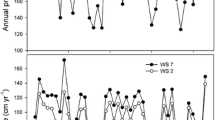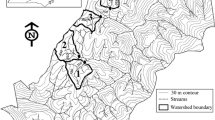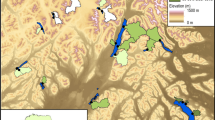Abstract
Variations in plant community composition across the landscape can influence nutrient retention and loss at the watershed scale. A striking example of plant species importance is the influence of N2-fixing red alder (Alnus rubra) on nutrient cycling in the forests of the Pacific Northwest. To understand the influence of red alder on watershed nutrient export, we studied the chemistry of 26 small watershed streams within the Salmon River basin of the Oregon Coast Range. Nitrate and dissolved organic nitrogen (DON) concentrations were positively related to broadleaf cover (dominated by red alder: 94% of basal area), particularly when near-coastal sites were excluded (r 2 = 0.65 and 0.68 for nitrate-N and DON, respectively). Nitrate and DON concentrations were more strongly related to broadleaf cover within entire watersheds than broadleaf cover within the riparian area alone, which indicates that leaching from upland alder stands plays an important role in watershed nitrogen (N) export. Nitrate dominated over DON in hydrologic export (92% of total dissolved N), and nitrate and DON concentrations were strongly correlated. Annual N export was highly variable among watersheds (2.4–30.8 kg N ha−1 y−1), described by a multiple linear regression combining broadleaf and mixed broadleaf–conifer cover (r 2 = 0.74). Base cation concentrations were positively related to nitrate concentrations, which suggests that nitrate leaching increases cation losses. Our findings provide evidence for strong control of ecosystem function by a single plant species, where leaching from N saturated red alder stands is a major control on N export from these coastal watersheds.





Similar content being viewed by others
References
J Aber W McDowell K Nadelhoffer A Magill G Berntsen M Kamakea S McNulty W Currie L Rustad I Fernandez (1998) ArticleTitleNitrogen saturation in temperate forest ecosystems: hypotheses revisited. BioScience 48 921–34
JD Aber KJ Nadelhoffer P Steudler JM Melillo (1989) ArticleTitleNitrogen saturation in northern forest ecosystems. BioScience 39 378–86
AE Bernhard ER Peele (1997) ArticleTitleNitrogen limitation of phytoplankton in a shallow embayment in northern Puget Sound. Estuaries 20 759–69
RE Bilby BR Fransen PA Bisson (1996) ArticleTitleIncorporation of nitrogen and carbon from spawning coho salmon into the trophic system of small streams: evidence from stable isotopes. Can J Fish Aqua Sci 53 164–73
D Binkley K Cromack D Baker Jr (1994) Nitrogen fixation by red alder: biology, rates, and controls. DE Hibbs DS DeBell RF Tarrant (Eds) The biology and management of red alder. Oregon State University Press Corvallis (OR) 57–72
D Binkley C Giardina (1998) ArticleTitleWhy do tree species affect soils? The warp and woof of tree–soil interactions. Biogeochemistry 42 89–106
D Binkley JP Kimmins MC Feller (1982) ArticleTitleWater chemistry profiles in an early successional and a mid successional forest in coastal British Columbia, Canada. Can J For Res 12 240–8
D Binkley P Sollins R Bell D Sachs D Myrold (1992) ArticleTitleBiogeochemistry of adjacent conifer and alder–conifer stands. Ecology 73 2022–33
RD Blew RL Edmonds (1995) ArticleTitlePrecipitation chemistry along an inland transect on the Olympic Peninsula, Washington. J Environ Qual 24 239–45
LR Boring WT Swank JB Waide GS Henderson (1988) ArticleTitleSources, fates and impacts of nitrogen inputs to terrestrial ecosystems: review and synthesis. Biogeochemistry 6 119–59
BT Bormann K Cromack Jr WO Russell III (1994) The influences of red alder on soils and long-term ecosystem productivity. DE Hibbs DS DeBell RF Tarrant (Eds) The biology and management of red alder. Oregon State University Press Corvallis (OR) 47–56
GW Brown AR Gahler RB Marston (1973) ArticleTitleNutrient losses after clear-cut logging and slash burning the Oregon Coast Range. Water Resources Res 9 1450–3
S Brozek (1990) ArticleTitleEffect of soil changes caused by red alder (Alnus rubra) on biomass and nutrient status of Douglas-fir (Pseudotsuga menziesii) seedlings. Can J For Res 20 1320–5
ML Cabrera MH Beare (1993) ArticleTitleAlkaline persulfate oxidation for determining total nitrogen in microbial biomass extracts. Soil Sci Soc Am J 57 1007–12
Carlton G. 1988. The structure and dynamics of red alder communities in the central Coast Range of western Oregon.: Oregon State University.
JE Cloern (2001) ArticleTitleOur evolving conceptual model of the coastal eutrophication problem. Mar Ecol Prog Ser 210 223–53
DW Cole M Rapp (1981) Elemental cycling in forest ecosystems. DE Reichle (Eds) Dynamic properties of forest ecosystems. IBP synthesis. Cambridge University Press Cambridge (UK)
Cole, DW, Compton, JE, Van Miegroet, H, Homann, PS, Edmonds, RL (1995) “Comparison of carbon accumulation in douglas-fir and reclalcter forests”. In: Mckee, WW, Kelly, JM (Eds.) Carbon forms and functions in forest soils. Soil Science Society of America, Madison, WI (USA), pp 527–546
JE Compton DW Cole (1998) ArticleTitlePhosphorus cycling and soil P fractions in Douglas-fir and red alder stands. For Ecol Manage 110 101–12
JE Compton PS Homann DW Cole (1997) ArticleTitleLeaf element concentrations and soil properties in successive rotations of red alder (Alnus rubra). Can J For Res 27 662–6
L Cromack Jr RE Miller OT Helgerson RB Smith HW Anderson (1999) ArticleTitleSoil carbon and nutrients in a coastal Oregon Douglas-fir plantation with red alder. Soil Sci Soc Am J 63 232–9
WS Currie JD Aber WH McDowell RD Boone AH Magill (1996) ArticleTitleVertical transport of dissolved organic C and N under long-term N amendments in pine and hardwood forests. Biogeochemistry 35 471–505
MD Davis (1973) ArticleTitlePollen evidence of changing land use around the shores of Lake Washington. Northwest Sci 47 133–48
RL Edmonds TB Thomas RD Blew (1995) ArticleTitleBiogeochemistry of an old-growth forested watershed, Olympic National Park, Washington. Water Resources Res 31 409–18
BP Finney I Gregory-Eaves J Sweetman MSV Douglas JP Smol (2000) ArticleTitleImpacts of climatic change and fishing on Pacific salmon abundance over the past 300 years. Science 290 795–9
JF Franklin CT Dyrness (1988) Natural vegetation of Oregon and Washington. Oregon State University Press Corvallis (OR)
CR Goldman (1961) ArticleTitleThe contribution of alder trees (Alnus tenuifolia) to the primary production of Castle Lake, California. Ecology 42 282–8
CL Goodale JD Aber WH McDowell (1961) ArticleTitleThe long-term effects of disturbance on organic and inorganic nitrogen export in the White Mountains, New Hampshire. Ecosystems 3 433–50
SE Greene PA Harcombe ME Harmon G Spycher (1992) ArticleTitlePatterns of growth, mortality and biomass change in a coastal Picea sitchensis–Tsuga heterophylla forest. J Veget Sci 3 697–706
P Gundersen VN Bashkin (1994) Nitrogen cycling. B Moldan J Cerny (Eds) Biogeochemistry of small catchments: a tool for environmental research. Wiley Chichester (UK) 255–83
CA Harrington JC Zasada EA Allen (1994) Biology of red alder (Alnus rubra Bong.). DE Hibbs DS DeBell RF Tarrant (Eds) The biology and management of red alder. Oregon State University Press. Corvallis (OR) 3–22
LO Hedin JJ Armesto AH Johnson (1995) ArticleTitlePatterns of nutrient loss from unpolluted, old-growth temperate forests: evaluation of biogeochemical theory. Ecology 76 493–509
JM Helfield RJ Naiman (2001) ArticleTitleEffects of salmon-derived nitrogen on riparian forest growth and implications for stream productivity. Ecology 82 2403–9
CJ Heusser (1964) ArticleTitlePalynology of four bog sections from the western Olympic Peninsula, Washington. Ecology 45 23–40
AH Hill (1996) ArticleTitleNitrate removal in stream riparian zones. J Environ Qual 25 743–55
WR Hill AW Knight (1988) ArticleTitleNutrient and light limitation of algae in two northern California streams. J Phycol 24 125–32
SE Hobbie (1992) ArticleTitleEffects of plant species on nutrient cycling. Trends Ecol Evol 7 336–9
PS Homann H Van Miegroet DW Cole GV Wolfe (1992) ArticleTitleCation distribution, cycling, and removal from mineral soil in Douglas-fir and red alder forests. Biogeochemistry 16 121–50
JW Hornbeck SW Bailey DC Buso JB Shanley (1997) ArticleTitleStreamwater chemistry and nutrient budgets for forested watersheds in New England: variability and management applications. For Ecol Manag 93 73–89
FS Hu B Finney LB Brubaker (2001) ArticleTitleEffects of Holocene Alnus expansion on aquatic productivity, nitrogen cycling, and soil development in southwestern Alaska. Ecosystems 4 358–68
NT Johnston CJ Perrin PA Slaney BR Ward (1990) ArticleTitleIncreased juvenile salmonid growth by whole-river fertilization. Can J Fish Aquat Sci 47 862–72
Larned ST. Nitrate and phosphate uptake lengths and short-term retention in Oregon Coast Range stream reaches with contrasting lithologies and channel substrates. Forthcoming.
G Likens C Driscoll D Buso (1996) ArticleTitleLong-term effects of acid rain: response and recovery of a forest ecosystem. Science 272 244–6
CJ Long C Whitlock PJ Bartlein SH Millspaugh (1998) ArticleTitleA 9000-year fire history from the Oregon Coast Range, based on a high-resolution charcoal study. Can J For Res 28 774–87
GM Lovett KC Weathers WV Sobczak (2000) ArticleTitleNitrogen saturation and retention in forested watersheds of the Catskill Mountains, New York. Ecol Appl 10 73–84
WH McDowell WS Currie JD Aber Y Yano (1998) ArticleTitleEffects of chronic nitrogen amendment on production of dissolved organic carbon and nitrogen in forest soils. Water AirSoil Pollut 105 175–82
Maguire, D, Waring, R, Cromack, K, Boyle, J (2000) “Trends in soil and foliar nutrients across a range in swiss needle cast severity.” In: Annual Report to the Swiss Needle Cast Cooperative,Oregon State University, covallis, OR (USA), pp 79–84
Miller, OH, Newton, A (2000) “Watersheds in Oregon’s Coast Range.” Agroecosystems 8: 153–164
PS Murdoch JL Stoddard (1992) ArticleTitleThe role of nitrate in the acidification of streams in the Catskill Mountains of New York. Water Resources Res 28 2707–20
RJ Naiman RE Bilby PA Bisson (2000) ArticleTitleRiparian ecology and management in the Pacific coastal rain forest. BioScience 50 996–1011
JL Ohmann MJ Gregory (2002) ArticleTitlePredictive mapping of forest composition and structure with direct gradient analysis and nearest neighbor imputation in Coastal Oregon, USA. Can J For Resources 32 725–41
K Ohrui MJ Mitchell (1997) ArticleTitleNitrogen saturation in Japanese forested watersheds. Ecol Appl 7 391–401
SS Perakis LO Hedin (2002) ArticleTitleNitrogen losses from temperate South American forests mainly as dissolved organic forms. Nature 415 416–9
WT Peterjohn DL Correll (1984) ArticleTitleNutrient dynamics in an agricultural watershed: observations on the role of a riparian forest. Ecology 65 1466–75
Remillard SM. 2000. Soil carbon and nitrogen in old-growth forests in western Oregon and Washington [thesis]. Oregon State University.
DG Silsbee GL Larson (1982) ArticleTitleWater quality of streams in the Great Smoky Mountains National Park. Hydrobiologia 89 97–115
P Sollins CC Grier FM McCorison KJ Cromack R Fogel RL Fredriksen (1980) ArticleTitleThe internal element cycles of an old-growth Douglas-fir ecosystem in western Oregon. Ecol Monogr 50 261–85
JM Stark SC Hart (1997) ArticleTitleHigh rates of nitrification and nitrate turnover in undisturbed coniferous forests. Nature 385 61–4
Stednick JD, Kern TJ. 1992. Long term effects of timber harvesting in the Oregon Coast Range: the New Alsea Watershed Study (NAWS). In: Jones ME, Laenen A, editors. Interdisciplinary approaches in hydrology and hydrogeology. American Institute of Hydrology. p 502–10.
“the circle”. In: Stockner, JG (Ed.) Nutrients in salmonid ecosystems: Sustaining production and biodiversity. American Fisheries Society, Symposium 34, Bethesda, MD (USA) pp 3–15
JL Stoddard (1994) Long-term changes in watershed retention of nitrogen: its causes and aquatic consequences. LA Baker (Eds) Environmental chemistry of lakes and reservoirs. Adv. Chem. Ser. No. American Chemical Society Washington (DC) 223–84
R Stottlemyer D Toczydlowski (1999) ArticleTitleSeasonal relationships between precipitation, forest floor, and streamwater nitrogen, Isle Royale, Michigan. Soil Sci Soc Am J 63 389–98
FJ Triska VC Kennedy RJ Avanzino GW Zellweger KE Bencala (1989) ArticleTitleRetention and transport of nutrients in a third-order stream: channel processes. Ecology 70 1877–92
USDA. 1997. Soil survey of Lincoln County area, Oregon. Washington (DC): US Department of Agriculture, National Resources Conservation Service.
InstitutionalAuthorNameUSEPA (1987) Handbook of methods for acid deposition studies: laboratory analyses for surface water chemistry. US Environmental Protection Agency, Office of Research and Development Washington, (DC)
H Van Miegroet DW Cole (1985) ArticleTitleAcidification sources in red alder and Douglas fir soils—importance of nitrification. Soil Sci Soc Am J 49 1274–9
H Van Miegroet DW Cole (1984) ArticleTitleImpact of nitrification on soil acidification and cation leaching in a red alder ecosystem. J Environ Qua 13 586–90
H Van Miegroet DW Cole NW Foster (1992) Nitrogen distribution and cycling. DW Johnson SE Lindberg (Eds) Atmospheric deposition and forest nutrient cycling: a synthesis of the Integrated Forest Study. Springer-Verlag New York 178–96
PM Vitousek JD Aber RW Howarth GE Likens PA Matson DW Schindler WH Schlesinger DG Tilman (1997) ArticleTitleHuman alteration of the global nitrogen cycle: sources and consequences. Ecol Appl 7 737–50
Volk CJ, Kiffney PM, Edmonds RE (2003) “Role of riparian alder in the nutrient dynamics of coastal streams of the Olympic Peninsula, Washington, U.S.A.” In: Stockner, JG (Ed.) Nutrients in salmonid ecosystems: Sustainnig production and biodiversity. American Fisheries society, symposium 34, Bethesda, MD (USA) pp 213–225
RH Waring JF Franklin (1979) ArticleTitleEvergreen coniferous forests of the Pacific Northwest. Science 204 1380–6
EB Welch JM Jacoby CW May (1998) Stream quality. RJ Naiman RE Bilby (Eds) River ecology and management: lessons from the Pacific Coastal Ecoregion. Springer-Verlag New York 69–94
PJ Wigington MR Church TC Strickland KN Eshleman J Van Sickle (1998) ArticleTitleAutumn chemistry of Oregon Coast Range streams. J Am Water Resources Assoc 34 1035–49
SM Wondzell FJ Swanson (1996) ArticleTitleSeasonal and storm dynamics of the hyporheic zone of a 4th-order mountain stream. II. Nitrogen cycling. J North Am Benthol Soc 15 20–34
RF Wright L Rasmussen (1998) ArticleTitleIntroduction to the NITREX and EXMAN projects. For Ecol Managemen 101 1–7
Acknowledgements
We thank Kathy Motter and the Willamette Research Station staff for water sample analysis, and Marjorie Storm and Joel Zumbolo for assistance with field sampling. We also thank Patti Haggerty and Gary Bishop for invaluable assistance with the GIS data, and Janet Ohmann and Matt Gregory for using their model to provide the CLAMS vegetation data by species. Sarah Greene of the Pacific Northwest Research Station provided field site access within Cascade Head Experimental Forest. Steven Perakis, Dan Binkley, and Phil Kaufmann gave us valuable comments on this manuscript. This work was funded by the US Environmental Protection Agency (EPA) and approved for publication after EPA review. Approval does not signify that the contents reflect the views of the agency, and the mention of trade names or commercial products does not imply endorsement.
Author information
Authors and Affiliations
Corresponding author
Rights and permissions
About this article
Cite this article
Compton, J., Church, M., Larned, S. et al. Nitrogen Export from Forested Watersheds in the Oregon Coast Range: The Role of N2-fixing Red Alder . Ecosystems 6, 773–785 (2003). https://doi.org/10.1007/s10021-002-0207-4
Received:
Accepted:
Published:
Issue Date:
DOI: https://doi.org/10.1007/s10021-002-0207-4




